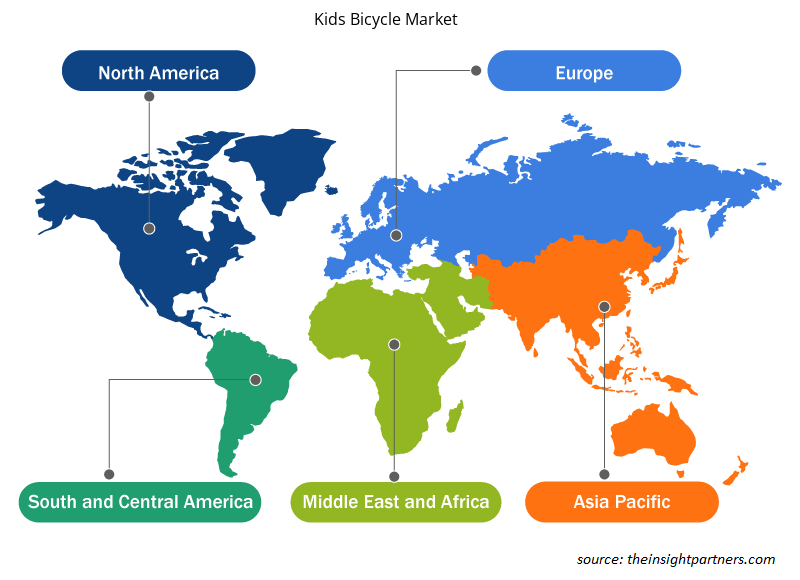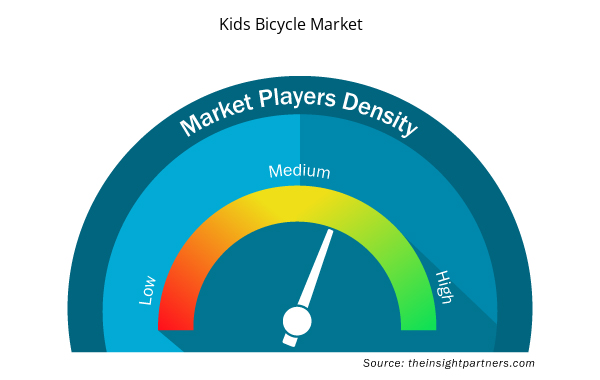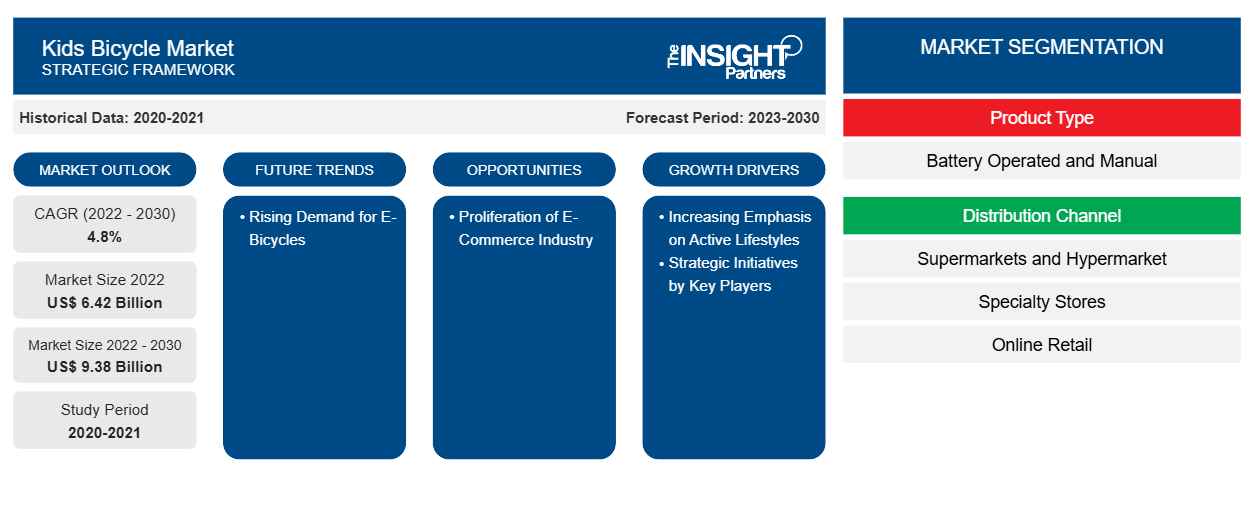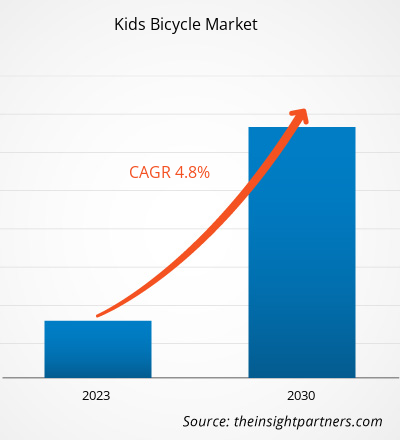[研究报告] 儿童自行车市场规模预计将从 2022 年的 64.2281 亿美元增长到 2030 年的 93.7972 亿美元;预计 2022 年至 2030 年市场复合年增长率为 4.8%。
市场洞察和分析师观点:
市场的主要驱动因素是人们越来越重视积极的生活方式,以及采用创新技术的产品数量激增。人们对儿童肥胖和体育锻炼重要性的认识不断提高,这促使父母选择自行车作为让孩子保持活跃的一种方式。此外,对电动自行车的需求不断增长,进一步促进了儿童自行车市场的增长。
增长动力和挑战:
日益重视积极的生活方式和主要市场参与者的战略举措是儿童自行车市场规模不断增长的因素之一。在不断发展的行业中,公司利用各种策略来获得竞争优势,扩大市场份额并与目标受众产生共鸣。一项突出的战略举措是并购。儿童自行车市场中的公司经常合并以整合资源,增强产品组合并利用协同效应。这些战略举措不仅有助于个别公司的增长,也有助于市场的整体活力和竞争力。
合作伙伴关系和协作也是儿童自行车行业主要参与者采取的值得注意的战略举措。公司可以通过与知名品牌、娱乐特许经营或教育机构结盟,利用现有的网络和现有的粉丝群。协作努力使公司能够结合各自的优势,开发创新的产品和有效的营销活动,以迎合年轻消费者及其父母的喜好。例如,2023 年 11 月,哈雷戴维森创立的 Serial 1 电动自行车品牌被出售给 LEV Manufacturing, Inc.(前身为 Life Electric Vehicles, Inc.)。Serial 1 将在美国本土建立电动自行车组装厂,这将降低自行车的价格。Serial 1 与 LEV Manufacturing 的合作确保了其对质量的承诺。美国专门的内部生产团队将支持 Serial 1 的优质电动自行车产品。
电动自行车需求的不断增长已成为儿童自行车市场趋势,反映出消费者偏好向创新和可持续的儿童交通解决方案的转变。配备电动辅助的电动自行车因其能够为儿童提供独特而刺激的骑行体验而越来越受欢迎。这些自行车通常具有可调节的功率水平。安全性是儿童自行车市场对电动自行车需求上升的另一个因素。家长们欣赏电动辅助控制的加速和制动功能,这提高了骑车人的整体安全性。这对可能对传统自行车的安全有顾虑的家长来说尤其有吸引力,因为电动自行车为孩子的骑行活动提供了额外的监督和控制。
父母的环保意识也影响了人们对电动自行车的偏好。电动自行车被认为比传统自行车更环保,这与人们日益重视可持续生活相一致。随着父母寻求向孩子灌输负责任的环保价值观的方法,选择电动自行车可能会继续在儿童自行车市场份额中占有一席之地。总体而言,对电动自行车的需求不断增长反映了技术创新、安全考虑和环保意识的融合,塑造了儿童交通和娱乐的不断发展格局。
安全问题是儿童自行车市场的一大制约因素,影响着消费者的购买决策和行业动态。父母越来越重视孩子在户外活动中的安全,而自行车——作为娱乐和交通的常见选择——正受到严格审查。促使父母寻求具有先进安全功能的自行车的一个主要问题是发生事故和受伤的可能性。这种意识的增强使消费者偏好转向配备增强型制动系统、耐用材料和可视性增强的自行车,以确保儿童获得更安全的骑行体验。对事故和受伤的恐惧增加了对头盔、护膝和护肘等防护装备的需求。虽然这些配件有助于保障儿童安全,但也增加了父母的额外成本。确保安全骑行体验的总成本,包括购买安全装备和可能更昂贵的具有先进安全功能的自行车。因此,日益增加的安全问题阻碍了儿童自行车市场的增长。
定制此报告以满足您的需求
您可以免费定制任何报告,包括本报告的部分内容、国家级分析、Excel 数据包,以及为初创企业和大学提供优惠和折扣
- 获取此报告的关键市场趋势。这个免费样品将包括数据分析,从市场趋势到估计和预测。
报告细分和范围:
全球儿童自行车市场分析考虑了以下几个部分 - 产品类型、分销渠道和地理位置。根据产品类型,市场分为电池供电和手动。根据分销渠道,儿童自行车市场细分为超市和大卖场、专卖店、在线零售和其他。儿童自行车市场报告的范围包括北美(美国、加拿大和墨西哥)、欧洲(德国、法国、意大利、英国、俄罗斯和欧洲其他地区)、亚太地区(澳大利亚、中国、日本、印度、韩国和亚太地区其他地区)、中东和非洲(南非、沙特阿拉伯、阿联酋和中东和非洲其他地区)以及南美洲和中美洲(巴西、阿根廷和南美洲和中美洲其他地区)。
节段分析:
根据产品类型,儿童自行车市场分为电池驱动和手动两种。到 2030 年,手动自行车预计将占据相当大的儿童市场份额。手动自行车市场包括传统自行车,依靠骑手的体力推动自行车前进。这些自行车有各种尺寸和设计,适合不同年龄段和技能水平的人。手动自行车是教孩子基本运动技能、平衡和协调能力的基础。家长们经常选择这些经典的自行车,因为它们为孩子们提供了一种永恒而有趣的户外活动方式,同时有助于他们的全面发展。
区域分析:
儿童自行车市场分为五个主要区域——北美、欧洲、亚太、南美和中美以及中东和非洲。就收入而言,亚太地区占据了儿童自行车市场份额的主导地位;2022 年该地区的市场价值为 21.677 亿美元。北美是该市场的第二大贡献者,占全球市场的约 28%。由于人们对儿童肥胖的认识不断提高,北美对儿童自行车的需求不断增加。随着人们对儿童肥胖和久坐行为的认识不断提高,人们越来越重视促进儿童健康积极的生活方式。随着父母和看护人优先考虑体育活动,对自行车作为儿童锻炼和户外娱乐方式的需求也随之增加。骑自行车可以燃烧卡路里、促进健康、锻炼肌肉和协调能力,使其成为一种有趣而有效的健康发展工具。
新冠疫情也导致儿童自行车需求上升。由于封锁和限制措施限制了各种户外运动和娱乐活动,家长们寻求其他方式让孩子们保持参与和活跃。骑自行车成为一种安全有趣的户外活动,孩子们可以在保持社交距离的同时享受和活动。这一因素导致了儿童自行车需求的增加。在过去的二十年里,美国俄勒冈州科瓦利斯学区 (CSD) 一直鼓励学生步行和骑自行车上学。所有五年级学生都参加为期一周的自行车安全课程,预计很快将扩展到其他年级。在“安全上学路线”(SRTS) 计划下,家长、学校、社区领袖以及地方、州和联邦政府正在支持和鼓励步行和骑自行车上学,以改善儿童的健康和福祉。
亚太地区人口占世界总人口的 60%,接近 43 亿,其中包括世界人口最多的国家中国和印度。随着人们越来越重视促进儿童的健康生活方式以及中产阶级人口的不断增长,近年来对儿童自行车的需求显著增加。在中国和印度等城市化和生活方式变化突出的国家,家长们越来越意识到户外活动对孩子的重要性。这种意识转化为对儿童自行车的需求增加,作为一种鼓励体育锻炼和提供娱乐方式的手段。
儿童自行车市场区域洞察
Insight Partners 的分析师已详细解释了预测期内影响儿童自行车市场的区域趋势和因素。本节还讨论了北美、欧洲、亚太地区、中东和非洲以及南美和中美洲的儿童自行车市场细分和地理位置。

- 获取儿童自行车市场的区域特定数据
儿童自行车市场报告范围
| 报告属性 | 细节 |
|---|---|
| 2022 年市场规模 | 64.2亿美元 |
| 2030 年的市场规模 | 93.8亿美元 |
| 全球复合年增长率(2022 - 2030 年) | 4.8% |
| 史料 | 2020-2021 |
| 预测期 | 2023-2030 |
| 涵盖的领域 | 按产品类型
|
| 覆盖地区和国家 | 北美
|
| 市场领导者和主要公司简介 |
|
市场参与者密度:了解其对商业动态的影响
儿童自行车市场正在快速增长,这得益于终端用户需求的不断增长,这些需求源于消费者偏好的不断变化、技术进步以及对产品优势的认识不断提高等因素。随着需求的增加,企业正在扩大其产品范围,进行创新以满足消费者的需求,并利用新兴趋势,从而进一步推动市场增长。
市场参与者密度是指在特定市场或行业内运营的企业或公司的分布情况。它表明在给定市场空间中,相对于其规模或总市场价值,有多少竞争对手(市场参与者)存在。
在儿童自行车市场运营的主要公司有:
- 斯科特体育公司
- 自行车运动集团
- GT 自行车有限公司
- 美利达工业有限公司
- 自行车公司
免责声明:上面列出的公司没有按照任何特定顺序排列。

- 了解儿童自行车市场主要参与者概况
行业发展和未来机遇:
儿童自行车市场主要参与者采取的各种举措如下:
- 2021 年,Specialized Bicycle Components Inc. 推出了 Jett,这是一款可调节的儿童自行车,旨在促进终身骑行。这款自行车比例完美,儿童可抬起,非常适合在道路和社区中使用。
- 2023年,Paco Bike Co Ltd 推出了多款新款车型,包括 20 英寸竞速公路车、24 英寸专业公路车碟刹、以及 26 英寸 Prorace CX 碟刹。
- 2023 年 7 月,ToysRus 宣布计划重新推出其独家儿童自行车系列。该公司专门为不同年龄段的儿童提供玩具,从简单的玩具到大型复杂的玩具一应俱全。他们用超级英雄和迪士尼公主来个性化自行车,以吸引孩子们的注意力并增加销量。
竞争格局和重点公司:
SCOTT Sports SA、Cycling Sports Group Inc、GT Bicycles LLC、Merida Industry Co Ltd、BikeCo LLC、Kona Bicycle Co、Paco Bike Co Ltd、Specialized Bicycle Components Inc、Trek Bicycle Corp 和 Giant Manufacturing Co Ltd 是儿童自行车市场报告中介绍的主要参与者。这些市场参与者正在采取战略发展举措进行扩张,进一步推动市场增长。
- 历史分析(2 年)、基准年、预测(7 年)及复合年增长率
- PEST 和 SWOT 分析
- 市场规模价值/数量 - 全球、区域、国家
- 行业和竞争格局
- Excel 数据集



Report Coverage
Revenue forecast, Company Analysis, Industry landscape, Growth factors, and Trends

Segment Covered
This text is related
to segments covered.

Regional Scope
North America, Europe, Asia Pacific, Middle East & Africa, South & Central America

Country Scope
This text is related
to country scope.
常见问题
The major players operating in the global kids bicycle market are are SCOTT Sports SA, Cycling Sports Group Inc, GT Bicycles LLC, Merida Industry Co Ltd, BikeCo LLC, Kona Bicycle Co, Paco Bike Co Ltd, Specialized Bicycle Components Inc, Trek Bicycle Corp, and Giant Manufacturing Co Ltd.
Based on product type, manual segment mainly has the largest revenue share. The manual segment of the kids' bicycle market comprises traditional bicycles that rely on the physical effort of the rider to move them forward. These bicycles come in various sizes and designs, catering to different age groups and skill levels. Manual bicycles are fundamental for teaching children essential motor skills, balance, and coordination.
In an ever-evolving industry, companies leverage various strategies to gain a competitive edge, expand their market share, and resonate with their target audience. One prominent strategic initiative is mergers and acquisitions. Companies within the kids bicycle market often merge to consolidate resources, enhance product portfolios, and capitalize on synergies. These strategic moves contribute not only to the growth of individual companies but also to the overall dynamism and competitiveness of the market.
The e-commerce industry also provides a platform for targeted marketing strategies. Manufacturers can leverage data analytics to understand consumer preferences and tailor their marketing efforts accordingly. This personalized approach allows more effective communication with parents, addressing their needs and concerns about kids bicycles. As the e-commerce ecosystem continues to evolve, companies in the kids bicycle market can harness these opportunities to enhance their online presence, streamline distribution channels, and ultimately drive growth in a digital retail landscape.
Based on the distribution channel, specialty stores segment is hold a significant share in the market. Specialty stores offer expertise, personalized service, and specialized product knowledge for any particular product. Specialty stores focusing on bicycles typically have knowledgeable staff who can guide parents in choosing the right bicycle based on a child's age, size, and specific needs. The dedicated focus on bicycles in these stores ensures a more comprehensive selection of high-quality products, including accessories and safety gear.
Asia Pacific accounted for the largest share of the global kids bicycle market. Asia Pacific is home to 60% of the world's population, nearly 4.3 billion people, and includes the world's most populous countries, China and India. With a rising emphasis on promoting healthy lifestyles for children and a growing middle-class population, the demand for kids bicycles has witnessed significant traction in recent years. In countries such as China and India, where urbanization and changing lifestyles are prominent, there is a heightened awareness among parents about the importance of outdoor activities for children. This awareness has translated into an increased demand for kids bicycles as a means to encourage physical activity and provide a mode of recreation.
Trends and growth analysis reports related to Consumer Goods : READ MORE..
The List of Companies - Kids Bicycle Market
- SCOTT Sports SA
- Cycling Sports Group Inc
- GT Bicycles LLC
- Merida Industry Co Ltd
- BikeCo LLC
- Kona Bicycle Co
- Paco Bike Co Ltd
- Specialized Bicycle Components Inc
- Trek Bicycle Corp
- Giant Manufacturing Co Ltd
The Insight Partners performs research in 4 major stages: Data Collection & Secondary Research, Primary Research, Data Analysis and Data Triangulation & Final Review.
- Data Collection and Secondary Research:
As a market research and consulting firm operating from a decade, we have published and advised several client across the globe. First step for any study will start with an assessment of currently available data and insights from existing reports. Further, historical and current market information is collected from Investor Presentations, Annual Reports, SEC Filings, etc., and other information related to company’s performance and market positioning are gathered from Paid Databases (Factiva, Hoovers, and Reuters) and various other publications available in public domain.
Several associations trade associates, technical forums, institutes, societies and organization are accessed to gain technical as well as market related insights through their publications such as research papers, blogs and press releases related to the studies are referred to get cues about the market. Further, white papers, journals, magazines, and other news articles published in last 3 years are scrutinized and analyzed to understand the current market trends.
- Primary Research:
The primarily interview analysis comprise of data obtained from industry participants interview and answers to survey questions gathered by in-house primary team.
For primary research, interviews are conducted with industry experts/CEOs/Marketing Managers/VPs/Subject Matter Experts from both demand and supply side to get a 360-degree view of the market. The primary team conducts several interviews based on the complexity of the markets to understand the various market trends and dynamics which makes research more credible and precise.
A typical research interview fulfils the following functions:
- Provides first-hand information on the market size, market trends, growth trends, competitive landscape, and outlook
- Validates and strengthens in-house secondary research findings
- Develops the analysis team’s expertise and market understanding
Primary research involves email interactions and telephone interviews for each market, category, segment, and sub-segment across geographies. The participants who typically take part in such a process include, but are not limited to:
- Industry participants: VPs, business development managers, market intelligence managers and national sales managers
- Outside experts: Valuation experts, research analysts and key opinion leaders specializing in the electronics and semiconductor industry.
Below is the breakup of our primary respondents by company, designation, and region:

Once we receive the confirmation from primary research sources or primary respondents, we finalize the base year market estimation and forecast the data as per the macroeconomic and microeconomic factors assessed during data collection.
- Data Analysis:
Once data is validated through both secondary as well as primary respondents, we finalize the market estimations by hypothesis formulation and factor analysis at regional and country level.
- Macro-Economic Factor Analysis:
We analyse macroeconomic indicators such the gross domestic product (GDP), increase in the demand for goods and services across industries, technological advancement, regional economic growth, governmental policies, the influence of COVID-19, PEST analysis, and other aspects. This analysis aids in setting benchmarks for various nations/regions and approximating market splits. Additionally, the general trend of the aforementioned components aid in determining the market's development possibilities.
- Country Level Data:
Various factors that are especially aligned to the country are taken into account to determine the market size for a certain area and country, including the presence of vendors, such as headquarters and offices, the country's GDP, demand patterns, and industry growth. To comprehend the market dynamics for the nation, a number of growth variables, inhibitors, application areas, and current market trends are researched. The aforementioned elements aid in determining the country's overall market's growth potential.
- Company Profile:
The “Table of Contents” is formulated by listing and analyzing more than 25 - 30 companies operating in the market ecosystem across geographies. However, we profile only 10 companies as a standard practice in our syndicate reports. These 10 companies comprise leading, emerging, and regional players. Nonetheless, our analysis is not restricted to the 10 listed companies, we also analyze other companies present in the market to develop a holistic view and understand the prevailing trends. The “Company Profiles” section in the report covers key facts, business description, products & services, financial information, SWOT analysis, and key developments. The financial information presented is extracted from the annual reports and official documents of the publicly listed companies. Upon collecting the information for the sections of respective companies, we verify them via various primary sources and then compile the data in respective company profiles. The company level information helps us in deriving the base number as well as in forecasting the market size.
- Developing Base Number:
Aggregation of sales statistics (2020-2022) and macro-economic factor, and other secondary and primary research insights are utilized to arrive at base number and related market shares for 2022. The data gaps are identified in this step and relevant market data is analyzed, collected from paid primary interviews or databases. On finalizing the base year market size, forecasts are developed on the basis of macro-economic, industry and market growth factors and company level analysis.
- Data Triangulation and Final Review:
The market findings and base year market size calculations are validated from supply as well as demand side. Demand side validations are based on macro-economic factor analysis and benchmarks for respective regions and countries. In case of supply side validations, revenues of major companies are estimated (in case not available) based on industry benchmark, approximate number of employees, product portfolio, and primary interviews revenues are gathered. Further revenue from target product/service segment is assessed to avoid overshooting of market statistics. In case of heavy deviations between supply and demand side values, all thes steps are repeated to achieve synchronization.
We follow an iterative model, wherein we share our research findings with Subject Matter Experts (SME’s) and Key Opinion Leaders (KOLs) until consensus view of the market is not formulated – this model negates any drastic deviation in the opinions of experts. Only validated and universally acceptable research findings are quoted in our reports.
We have important check points that we use to validate our research findings – which we call – data triangulation, where we validate the information, we generate from secondary sources with primary interviews and then we re-validate with our internal data bases and Subject matter experts. This comprehensive model enables us to deliver high quality, reliable data in shortest possible time.


 获取此报告的免费样本
获取此报告的免费样本